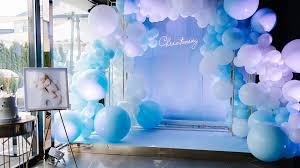Introduction
Have you ever walked into a party or event and felt wowed by the decorations? Bright colors, shapes, textures, light — everything works together to catch your eye. Balloon decorations are one of the easiest and most fun ways to create that wow. You don’t need to be an artist; with some tools, practice, and creativity, you can turn simple balloons into something beautiful.
Why Balloon Decorations Are So Popular
- Instant cheer and fun: Balloons bring light, color, and a festive feeling right away. They lift moods.
- Affordable: Compared to many kinds of decorations (flowers, large prints, rentals), balloons are often cheaper for the effect you get.
- Versatile: You can shape them, combine them, hang them, float them, tie them — lots of ways to use them.
- Easy to learn: With some practice, you can make designs that look good even if you’re new.
- Highly customizable: For any theme, color scheme, age group, indoor/outdoor event, balloons can be adapted.
Types of Balloon Decorations
Here are the common styles, with ideas:
Balloon Garlands
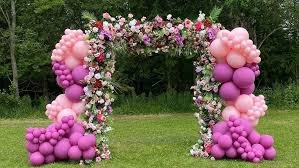
Long strings or curves of balloons, often of different sizes, twisted or tied together. Good for entrances, over tables, around door frames.
Balloon Arches Columns
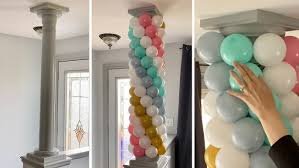
Arches frame a space: for entrance, stage, cake table. Columns are vertical stacks — can be single-column or pairs. They give height.
Balloon Walls Backdrops
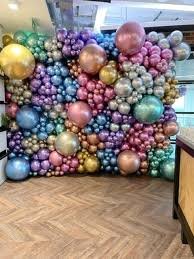
These are bigger and take up more space. Great for photo booths, behind the cake, or on a stage. They become focal points.
Balloon Centerpieces
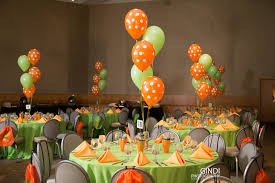
For tables or small spaces. A cluster of balloons, maybe mixed with flowers or lights. Adds sparkle without taking up too much room.
Ceiling Balloons Floating Installations

Fill ceiling with balloons (helium or air with ribbons hanging), have floating clusters, or strands. Creates a magic above heads.
Sculptures Themed Balloons
Shape balloons into characters, numbers, letters, animals. Useful for children’s parties, themed events like weddings or anniversaries.
Tools Materials Needed
To get good results, you’ll need decent tools and materials. Here’s a checklist.
Balloons Latex vs Foil vs Specialty
- Latex: stretchy, many colors, usually cheaper, biodegradable kinds available.
- Foil/Mylar: shinier, holds helium better, shaped designs (letters, hearts). But more expensive and less eco-friendly.
- Specialty: confetti inside, chrome finish, extra large, glow-in-the-dark etc.
Inflation tools
- Balloon hand pump / electric pump
- Helium tank (if you need floating balloons)
- Air compressor (sometimes)
Frames tapes strings glue dots etc.
- Fishing line or strong transparent string
- Balloon tape or strip (for garlands)
- Glue dots or balloon glue for sticking balloons together or adding accents
- Frames or rods for arches and columns
- Weights (for helium balloons so they don’t float off)
Lights greenery accessories
- Fairy lights or LED string lights
- Flowers, greenery (real or fake)
- Ribbon, tassels, fringe
- Personalised cut-outs, numbers, letters etc.
Planning Your Balloon Design
Before inflating a single balloon, good planning helps make the result look clean and impressive.
Theme, color palette, mood
Decide what your event is: birthday, wedding, baby shower, corporate, etc. Pick 2-4 main colours. Choose if you want soft / pastel / romantic, bold / vibrant / playful, elegant etc.
Choosing shapes, sizes, layout
Mix large and small balloons. Big ones catch attention, small ones fill gaps. Use different shapes – round, long, confetti inside, foil shapes. Sketch where the decorations will go.
Indoor vs outdoor considerations
Outdoors: wind, sun, heat, weather. Indoors: ceiling height, walls, lighting. Outdoor decor must be more stable, choose materials that handle the environment.
Timing preparation
Make as much as you can ahead of time. Inflate balloons only when close to the event (late if using helium), put together parts (like garlands) in advance. Transport carefully so nothing pops or deflates.
How to Create Balloon Decorations Step by Step
Here are some projects with basic steps.
Simple Garland
- Choose your balloon sizes & colors.
- Inflate balloons to different sizes.
- Use balloon tape or fishing line to attach balloons: start with bigger ones, fill gaps with smaller ones.
- Add accents (greenery, lights, foil balloons) where needed.
- Hang or mount the garland at the entrance or over tables.
Arch or Column
- Build or buy frame or arch kit (PVC, wire, metal poles).
- Inflate balloons.
- Tie balloons around the frame, beginning from base, going up. Use support and tie securely.
- Add decorative elements like foil balloons or greenery.
Backdrop Wall
- Select a backdrop frame or use a wall.
- Plan the pattern: mixed sizes, repeated colors, maybe blocks of colors.
- Assemble in sections: easier to transport or attach.
- Add lighting or accessories to make it pop in photos.
Table Centrepiece
- Choose center design: small cluster vs tall stand.
- Use a base (weight, stand) so it doesn’t tip.
- Mix shapes and sizes. Maybe a foil number or letters for personalization.
- Add ribbon or lights for effect.
Tips to Make It Look Professional
Even with simple designs, these touches help you look like a pro.
- Balance & proportion: don’t have too many big balloons or too many small ones — mix them.
- Use quality materials: cheap balloons may pop, fade, look dull. Quality latex or foil lasts longer, looks brighter.
- Finishing touches: hide the basics (knots, strings), add accents like glitter, greenery, lights. Use color tones that go well together.
- Problem solving:
- If balloons pop: always have extras.
- Direct sunlight: protects from heat, or shade. Use lighter colours outdoors.
- For outdoor winds: secure bases, heavy weights, frames.
Balloon Decoration Trends
Stay up to date with what people are liking right now:
- Eco-friendly / biodegradable materials: more people care about environment. Using latex that decomposes, avoiding single-use plastics.
- Organic and asymmetric designs: instead of perfectly symmetrical arches, more flowing, uneven, natural shapes with balloons of different sizes
- Metallic & textured finishes: rose-gold, chrome, glitter, textured surfaces. Adds luxury.
- Interactive / photo-friendly installations: walls or backdrops for photos, installations people can walk through.
- Bold & unexpected color combinations: going beyond matching pastels — use contrast, neon, unusual pairings
Balloon Decoration as a Business
If you love balloon decorating, you might want to turn it into something more than a hobby.
- Pricing & cost considerations: Calculate your cost of materials, labour, transportation. Add in profit margin. Don’t forget hidden costs like renting equipment, electricity, cleanup.
- Marketing & attracting clients: Use photos (before/after), social media, word-of-mouth, partnerships with event planners. Offer packages. Build a portfolio.
- Managing orders & logistics: Have a system for bookings, deposit, timelines. Ensure you can transport delicate items safely. Time for setup and takedown.
- Safety, environment, disposing responsibly: Use biodegradable latex balloons. Don’t release balloons into open sky. Properly dispose popped or deflated balloons. Be aware of local regulations.
Challenges How to Deal With Them
It’s not always smooth — here are common issues and how to handle them.
- Weather & outdoor issues: Heat causes balloons to expand and pop; wind can damage installations; sun fades color. Use shade, lightweight but strong frames; avoid dark colours under direct sun.
- Budget constraints: Choose fewer, larger balloons rather than many small ones; skip extras if not needed; reuse what you can.
- Time management: Balloon work takes time. Do prep ahead. Have helpers. Prioritize what will be most seen.
- Working with helpers or team: Clear instructions; plan who does what; ensure consistency in technique. Small mistakes compound.
Table of Contents
Introduction
Why Balloon Decorations Are So Popular
Types of Balloon Decorations
Balloon Garlands
Balloon Arches & Columns
Balloon Walls & Backdrops
Balloon Centerpieces
Ceiling Balloons & Floating Installations
Sculptures & Themed Balloons
Tools & Materials Needed
Balloons: Latex vs Foil vs Specialty
Inflation tools (pumps, helium etc.)
Frames, tapes, strings, glue dots etc.
Lights, greenery, accessories
Planning Your Balloon Design
Theme, color palette, mood
Choosing shapes, sizes, layout
Indoor vs outdoor considerations
Timing & preparation
How to Create Balloon Decorations Step by Step
Simple garland
Arch or column
Backdrop/wall
Centerpiece or table décor
Tips to Make It Look Professional
Balance & proportion
Quality materials
Finishing touches
Problem solving (balloons popping, fading, uneven shapes)
Balloon Decoration Trends
Eco-friendly / biodegradable materials
Organic and asymmetric designs
Metallic and textured finishes
Interactive / photo-friendly installations
Bold & unexpected color combinations
Balloon Decoration as a Business
Pricing & cost considerations
Marketing & attracting clients
Managing orders, logistics, transport
Safety, environment, disposing of balloons responsibly
Challenges & How to Deal With Them
Weather & outdoor issues
Budget constraints
Time management
Working with helpers or team
Conclusion
Conclusion
Balloon decorations are more than just party filler — they’re a way to bring joy, color, and personality to any event. If you’ve ever thought that decorating with balloons might be your thing, there’s no reason not to try. With a bit of planning, good materials, and creativity, you can create decorations that are beautiful, memorable, and suited to your style.If you enjoy crafting, exploring new ideas, and seeing people smile, balloon decorating can be both a fun hobby and even a source of income. Remember to respect the environment, plan for challenges, and let your creativity shine. When you put in the effort, the result can be something truly magical.
